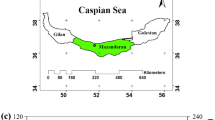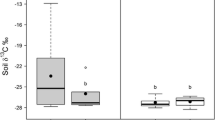Abstract.
To investigate the importance of the availability of food resources for soil micro- and mesofauna, carbon (as glucose) and nutrients (nitrogen as NH4NO3; phosphorus as NaH2PO4) were added separately and in combination to experimental plots in a beechwood on limestone (Göttinger Wald) for 15 months. The aim of the study was to increase the amount of resources (microorganisms) for the soil micro- and mesofauna and to observe changes in their density, i.e. to evaluate the strength of bottom-up forces. Furthermore, we wanted to investigate changes in the density of animals which feed on micro- and mesofauna, i.e. predacious animals including Gamasina, Uropodina and predatory Nematoda. In the litter layer the density of all animal groups studied was not significantly affected by experimental manipulations. In the soil animal groups responded differently but not parallel to the amount of respective food resources. The density of oribatid and uropodid mites declined in the C only treatment and the decline in oribatid mites was more pronounced when C and P were added in combination. Collembolan density also declined in the CP treatment. In contrast, Nematoda and Protozoa increased in density after the addition of C, N or P. The number of amoebae increased when P was added and this increase was most pronounced in the CP treatment. Flagellate density increased slightly in C treatment but the increase was stronger in CN, CP and CNP treatments. Gamasina did not respond significantly to experimental manipulations. The results point to a differential response of soil animal groups to an increased supply of food resources. We assume that the responses were strongly influenced by indirect effects caused by the increased number and biomass of earthworms in C treatments. Presumably, high density and biomass of earthworms stimulated populations of Nematoda, Amoebae and Flagellata while it detrimentally affected collembolans and particularly oribatid mites. It is concluded that in the forest studied litter consumption, bioturbation and mucus excretion by earthworms negatively affects the habitable space of collembolans and oribatid mites but improves habitat conditions for microfauna by increasing the water content. Therefore, earthworm effects may superimpose bottom-up forces confirming that earthworms are important ecosystem engineers in mull forest soils.
Similar content being viewed by others
Author information
Authors and Affiliations
Additional information
Electronic Publication
Rights and permissions
About this article
Cite this article
Maraun, M., Alphei, J., Beste, P. et al. Indirect effects of carbon and nutrient amendments on the soil meso- and microfauna of a beechwood. Biol Fertil Soils 34, 222–229 (2001). https://doi.org/10.1007/s003740100403
Received:
Issue Date:
DOI: https://doi.org/10.1007/s003740100403




